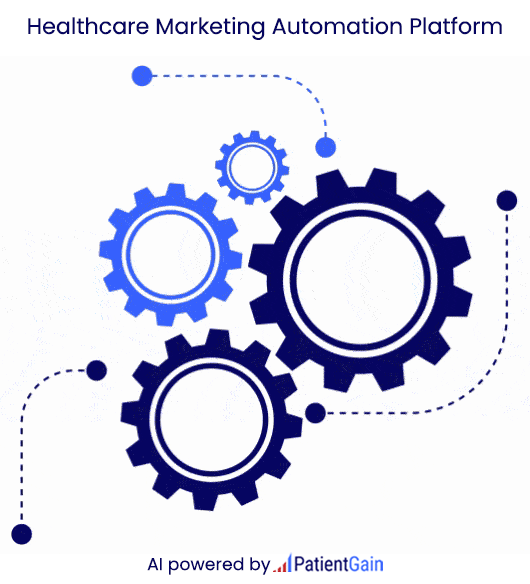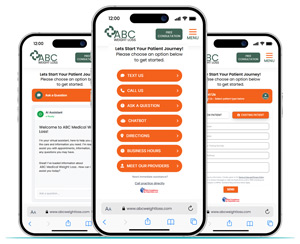What is a High Conversion Medical Spa Website?
A high-conversion med spa website is designed to turn website visitors into paying clients. It focuses on optimizing the user experience to encourage bookings, form submissions, and phone calls. This is achieved through various strategies like intuitive design, compelling visuals, clear calls-to-action, and leveraging social proof to build trust and drive conversions. Key characteristics of a high-conversion medical spa website include a combination of effective design, strategic content, and conversion-focused features and applications that are embedded within the website. These elements ensure that visitors are engaged, educated, and motivated to take action, such as clicking on “Contact Us”, booking an appointment, requesting more information, or calling the medical spa practice.

How is a High-Conversion Medical Spa Website different from a beautiful custom website designed by my local website company?
A high-conversion Medical Spa Website is a strategically designed digital platform whose primary purpose is to effectively and efficiently persuade a visitor to take a specific, desired action—like booking a consultation or requesting an appointment.
It’s not just a beautiful online brochure; it’s a highly skilled & intelligent “digital consultant” that works 24/7 to guide potential clients from curiosity to commitment. It is A/B Tested for good results and has been tested to produce excellent ROI for your med spa practice.
The “conversion rate” is a measurable metric. For example, if 100 people interested in med spa services your target area, visit your website and 5 of them fill out a consultation request form, your website has a 5% conversion rate for that specific action. A “high-conversion” website is one that is expertly optimized to maximize this percentage. Most websites have a an average conversion rate of around 4% – PatientGain designed websites have an average conversion rate of 10% or higher.
While a beautiful custom website from a local company might prioritize aesthetics and general online presence – this is our typical experience based on last 10+ years. However, a conversion-focused medical website design prioritizes user experience, clear calls to action, and strategic content to drive bookings and inquiries, whereas a beautiful website might emphasize visual appeal without necessarily optimizing for conversions.
Why is the website cost so high for a medical spa?
The reason for this high cost is that you are not simply buying a “website.” You are investing in a complex, secure, and strategic patient acquisition platform. The cost of a medical spa website is typically higher compared to standard business websites due to several factors that are unique to the medical and aesthetic industry.

1. Custom Design and Aesthetic Focus
A medical spa website needs to reflect the luxury, quality, and professionalism of the services provided. This requires a custom design that is both visually stunning and aligned with the brand’s image.
- Why it costs more: Designing a unique and aesthetically appealing website that fits the spa’s brand identity requires specialized graphic designers, photos, and videos to capture high-quality visuals, professional photos of treatments, and real clients testimonials. Example: A luxury med spa offering services like Botox or facial rejuvenation may require custom design elements such as before-and-after galleries, professional video tours, or photo shoots of the spa’s services.
2. Advanced Features and Functionality
Medical spas often require advanced functionality that goes beyond a basic website, including:
- Conversion tracking, leads capture software that integrate with your CRM the website.
- HIPAA-compliant apps and chatbots for secure communication.
- Custom forms for collecting sensitive patient data securely.
- Offers app to capture leads and provide a reason for your practice to be selected, rather than your competitor.
- Why it costs more: Developing these advanced features often requires custom software development, integration with other systems, and a higher level of technical expertise. Example: An intelligent online leads capture app with integrated CRM for your med spa requires specialized development.
3. Search Engine Optimization (SEO) for Med Spa Websites
A medical spa needs SEO to rank highly for relevant search terms like “best medical spa near me” or “Botox treatments in [City]”. SEO for medical spas involves both on-page and off-page optimization, which can be time-consuming and requires expertise.
- Why it costs more: SEO optimization requires constant content development, keyword research, local SEO optimization, link building, and continuous monitoring and updating to maintain top rankings in competitive local markets. Example: For a facial treatment clinic in Miami, SEO optimization would include creating location-specific content, optimizing Google My Business listings, and acquiring backlinks from local, trusted sources to increase visibility.
4. Compliance with Legal and Regulatory Standards (HIPAA)
Medical spas are subject to stringent legal and HIPAA compliance requirements. Since they deal with patient information, it is critical that the website adheres to privacy and security regulations.
- Why it costs more: Ensuring HIPAA compliance involves securing all forms of patient data, including appointment bookings, contact forms, and payment details. This requires encrypted communication, secure hosting, and specialized software development to protect protected health information (PHI). Example: A medical spa that offers Botox consultations may need a secure online form for patient registration and inquiries. This form would need to ensure that any data entered, such as name, phone number, and medical history, is encrypted to comply with HIPAA standards.
5. Ongoing Maintenance and Updates
Unlike basic business websites, medical spa websites require ongoing maintenance to stay up-to-date with the latest trends in aesthetics, technology, and medical regulations.
- Why it costs more: Websites need regular updates, whether it’s maintaining secure software, adjusting to changes in search algorithms, or adding new treatment services to keep the website fresh and relevant. Additionally, the platform should evolve to accommodate growing patient bases and adapt to new marketing strategies. Example: A medical spa may need to update their website regularly with new treatment offerings, promotional packages, or seasonal discounts. This continuous management can result in additional costs.
6. High Competition and Differentiation
Medical spas are often in competitive local markets, so the website must not only be functional but also stand out from the competition.
- Why it costs more: To differentiate a high-end medical spa, the website often includes custom features like luxurious design elements, interactive content, and unique patient testimonials, all of which require more time and effort to develop. Example: A high-end spa in Beverly Hills might include virtual consultations, immersive 3D virtual tours of its facility, and sophisticated booking systems, which differentiate it from other spas in the area and justify the higher website cost.
7. Integration with Marketing and Lead Generation Apps
Medical spa websites often integrate with CRM systems, email marketing platforms, and social media channels to create an effective lead generation and patient acquisition system.
- Why it costs more: Integrating multiple marketing tools to track and follow up on leads, schedule reminders, and nurture potential patients involves complex back-end integrations. These features help ensure a seamless user experience and effective marketing automation. Example: A medical spa might integrate its website with a CRM (Customer Relationship Management) system like PatientGain that tracks leads, manages status, and sends targeted email campaigns every month for upcoming promotions.
8. Advanced Real-Time AI Medical Marketing Dashboards
A live medical marketing dashboard for a practice provides a real-time, centralized view of key performance indicators (KPIs) related to marketing efforts, helping to track and optimize campaign performance, new patient conversions, engagement, and overall medical marketing for your practice.
- Why it costs more: Setting up advanced analytics with conversion tracking and patient behavior insights requires specialized expertise to measure effectiveness and optimize user experience. Example: A medical spa can use tools like Google Analytics and integrate them with platforms like PatientGain to understand how many visitors are booking Botox consultations, how long they stay on the site, and where they drop off in the booking process.
The Biggest Factor – Non-Negotiable HIPAA Compliance & Security
This is the single largest differentiator and a significant cost driver. A general website builder cannot provide this.
- What you’re paying for:
- Secure Hosting & Infrastructure: The site must be hosted on a HIPAA-eligible platform (like a properly configured AWS environment), which is more expensive than standard web hosting.
- HIPAA-Compliant Applications: Every tool that handles patient data—from the contact form and chatbot to the online scheduler—must be built to be HIPAA-compliant, ensuring data is encrypted and transmitted securely.
- Legal & Administrative Overhead: The website company must have internal policies, training, and security measures in place. They must also provide you with a Business Associate Agreement (BAA), a legal contract where they accept liability for protecting your patients’ data. This legal and operational framework has a real cost.
What steps you can take to increase the conversion rates of a med spa practice?
Key Features of a High-Conversion Medical Spa Website
1. Clear and Prominent Calls to Action (CTAs)
- CTAs are buttons or links that encourage website visitors to take the next step, whether it’s booking a consultation, signing up for a newsletter, or calling for more information.
- Best Practice: Place action-oriented CTAs like “Book Your Appointment”, “Get Your Free Consultation”, and “Claim Your Offer” in prominent positions on the website, such as on the homepage, service pages, and throughout the site.
Example: A medical spa offering Botox treatments might have a CTA button that says “Book Your Botox Consultation Now” directly under a description of the service, with another CTA on the contact page that says “Schedule Your Free Consultation”.
2. A/B Tested Navigation Menus of Website
- The website must have an easy-to-navigate structure, ensuring visitors can find the information they need quickly. Complicated menus or hard-to-find information can lead to visitors leaving the site before they convert.
- Best Practice: Keep the navigation simple with clear categories like Services, About Us, Contact, and Book Now. The site should be organized logically, allowing potential patients to easily learn about your services, view pricing, and schedule appointments.
Example: A medical spa’s homepage might feature a sticky navigation bar that follows the user as they scroll down, providing one-click access to Botox, facials, and laser treatments.
3. Responsive and Mobile-First Design
- A high-conversion website must be mobile-friendly, as many patients will access the site from their phones or tablets. A responsive design ensures the site functions seamlessly across devices and screen sizes.
- Best Practice: Ensure the website adapts to various screen sizes, with buttons, forms, and images optimized for mobile use. A mobile-optimized website will provide a smooth user experience and increase conversions.
Example: If a visitor is browsing a med spa’s services from their mobile phone, they should be able to easily tap on a “Contact Now” button, which takes them directly to a Contact app. (Intelli*Connect App offering features like secure messaging, SMS/Text messaging, tracking of new patient calls, Chat*Bot for after hours, CRM leads Funnel App and HIPAA compliance)
4. Clear, Informative, and Relevant Content
- The content on the website should be clear, persuasive, and educational to help visitors understand the value of the services being offered. This builds trust and confidence, encouraging potential patients to take action.
- Best Practice: Provide detailed descriptions of your treatments, along with patient testimonials, before-and-after galleries, and FAQs. Including compelling copy with information on the benefits and expected outcomes of each service can help potential patients feel more confident in choosing your spa.
Example: A medical spa offering facials might include before-and-after photos of real clients, with testimonials saying how the treatment improved their skin, and a detailed explanation of the facial process, how it works, and the benefits it provides.
5. Online AI Based Contact App
- AI Based intelligent app on your website can increase conversions. Usually healthcare practices have multiple apps – For example 1) Call tracking app 2) Booking app 3) Texting app 4) promotions app 5) Forms app 6) Leads capture 7) Leads funnel app 8) VIP app 9) Check insurance coverage app. Replace all of these with a single app. This app is an automated AI based system, where all inquiries from new and existing patients go to a Leads Funnel. Intelli*Connect App from PatientGain. A HIPAA-compliant patient communication app ensures secure and private exchange of Protected Health Information (PHI) between healthcare providers and patients.
- Online booking is a must for any high-conversion medical spa website. By allowing potential patients to book their consultations or treatments directly on the website, you make the process more convenient and efficient.
- Best Practice: Integrate an online scheduling system that is easy to use, and show real-time availability for different treatment types.
Example: A laser hair removal clinic might offer a “Contact Now” button for specific treatment sessions (e.g., full-body laser hair removal), allowing visitors to choose from multiple ways to contact you.
6. Trust-Building Elements (Reviews, Testimonials, Certifications)
- Trust is critical in the medical spa industry. Building trust through patient testimonials, before-and-after galleries, professional certifications, and industry awards increases credibility and boosts conversion rates.
- Best Practice: Showcase positive reviews, patient stories, and real-life before-and-after images to demonstrate the success and satisfaction of previous clients. You can also include any accreditations and professional memberships to establish authority.
Example: A medical spa offering Botox might display a video testimonial from a real patient discussing their experience with Botox, and include certifications from FDA-approved treatment providers.
7. Speed and Performance Optimization
- A slow website can lead to high bounce rates and poor conversion. The website should load quickly, ideally in under 3 seconds, to keep visitors engaged and prevent them from leaving.
- Best Practice: Use optimized images, minimize heavy scripts, and ensure fast page load times. This ensures a seamless user experience, especially for mobile users who tend to abandon slow-loading sites.
Example: A medical spa’s website might feature optimized images of treatments and services, ensuring fast load times for visitors browsing on mobile or desktop devices.
8. Effective Use of Lead Magnets
- Offering free resources in exchange for patient contact information is a great way to build your leads database. This can be in the form of eBooks, guides, or discounts for new patients.
- Best Practice: Provide downloadable content, such as a free skincare guide or a 10% discount for first-time clients, to collect lead information and follow up with email marketing or automated text reminders.
Example: A medical spa offering laser treatments might provide a free guide on “How to Prepare for Your First Laser Treatment”, asking users to fill out a short form with their email address to download the guide.
Conclusion:
A high-conversion medical spa website is designed to attract, engage, and convert visitors into loyal paying patients. By focusing on clear CTAs, mobile optimization, easy contact app, educational content, and trust-building elements, these websites create a seamless, engaging, and trustworthy experience for potential patients.


